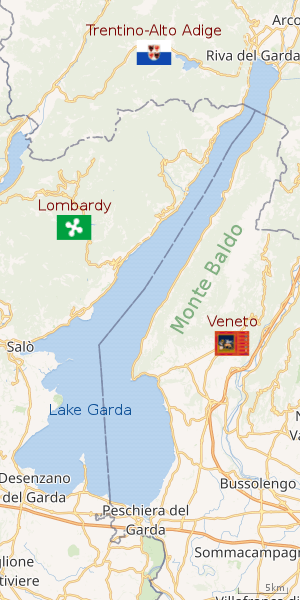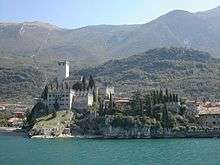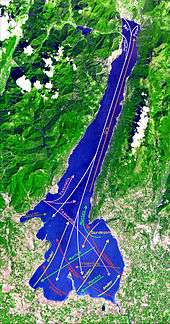Lake Garda
Lake Garda (Italian: Lago di Garda [ˈlaːɡo di ˈɡarda] or (Lago) Benaco [beˈnaːko]; Eastern Lombard: Lach de Garda; Venetian: Ƚago de Garda; Latin: Benacus) is the largest lake in Italy. It is a popular holiday location in northern Italy, about halfway between Brescia and Verona, and between Venice and Milan on the edge of the Dolomites. Glaciers formed this alpine region at the end of the last Ice Age. The lake and its shoreline are divided between the provinces of Verona (to the south-east), Brescia (south-west), and Trento (north). The name Garda, which the lake has been seen referred to in documents dating to the eighth century, comes from the town of the same name. It is the evolution of the Germanic word warda, meaning "place of guard" , "place of observation" or "place of safety " .
| Lake Garda | |
|---|---|
 Nago–Torbole and the northern part of the lake | |
| Coordinates | 45°38′N 10°40′E |
| Native name | Lago di Garda / Benaco (Italian) Lach de Garda (Lombard) Ƚago de Garda (Venetian) |
| Primary inflows | Sarca |
| Primary outflows | Mincio |
| Catchment area | 2,350 km2 (910 sq mi) |
| Basin countries | Italy |
| Max. length | 51.6 km (32.1 mi) |
| Max. width | 16.7 km (10.4 mi) |
| Surface area | 369.98 km2 (142.85 sq mi) |
| Average depth | 136 m (446 ft) |
| Max. depth | 346 m (1,135 ft) |
| Water volume | 50.35 km3 (40,820,000 acre⋅ft) |
| Residence time | 26.8 years |
| Shore length1 | 158.4 km (98.4 mi) |
| Surface elevation | 65 m (213 ft) |
| Islands | 5 (Isola del Garda, Isola San Biagio) |
| Settlements | see article |
| 1 Shore length is not a well-defined measure. | |
Geography
 |

The northern part of the lake is narrower, surrounded by mountains, the majority of which belong to the Gruppo del Baldo. The shape is typical of a moraine valley, probably having been formed under the action of a Paleolithic glacier. Although traces of the glacier's actions are evident today, in more recent years it has been hypothesised that the glacier occupied a previously existing depression, created by stream erosion 5 to 6 million years ago.
The lake has numerous small islands and five main ones, the largest being Isola del Garda where in 1220 St. Francis of Assisi founded a monastery, in its place now stands a nineteenth-century building in the Venetian Gothic style. Nearby to the south is Isola San Biagio, also known as the Isola dei Conigli ("Island of the Rabbits"). Both are offshore of San Felice del Benaco, on the lake's western side. The three other main islands are Isola dell'Olivo, Isola di Sogno, and Isola di Trimelone, all farther north near the eastern side. The main tributary is the Sarca River, others include the Ponale River (fed by Lago di Ledro), the Varone/Magnone River (via the Cascate del Varone) and various streams from both mountain sides, while the only outlet is the Mincio River (79 metres (259 ft), at Peschiera). The subdivision is created by the presence of a fault submerged between Sirmione and Punta San Vigilio which is almost a natural barrier that hampers the homogenization between the water of the two zones.
If the water level of the Adige river is too high, excess water is diverted to the lake through the Mori-Torbole tunnel.
Climate

The particularly mild climate favours the growth of some hardy Mediterranean plants, including the olive tree, parasol pine, mediterranean cypress, chinese windmill palm and Canary Island Date Palm. Some hardy Citrus trees, such as hardy lemons and satsuma can also be found, which are extremely rare at this latitude (46° North).[1] This greatly favoured the development of tourism since the end of the second world war. In ancient times, poets like Catullus wrote about "Lacus Benacus" with its mild climate vivified by the winds. The lake is oriented from north to south towards the Po Valley, so many winds typical of the lake are the result of a difference between lower and higher altitude temperatures. Due to this, winds are generated that descend from the mountains to the plains in the morning and go back to the mountains in the afternoon. The bottleneck formed by the lake basin affects the timing of the winds, many of which happen on a regular daily basis. The winds are all named, most in regional Italian dialect so a single wind may have different names.
Biology
Salmo carpio, also known as the carpione (carpione del Garda[2][3] or Lake Garda carpione[4]) is a rare salmonid fish endemic to Lake Garda. It has been introduced to a number of other lakes in Italy and elsewhere but unsuccessfully in all cases.[2] The population in Lake Garda has been strongly declining, and is considered critically endangered (IUCN 3.1).[3][4] The main threats are due to overfishing, pollution and possibly competition from introduced species such as Coregonus and other Salmonidae.[5]
Adult lake trout outside the mating season are silvery with very few black spots on the body and almost none on the head. During the mating season some males develop a dark mottled body coloration. Garda lake trout reach a length of up to 50 centimeters. They live primarily in depths of 100 to 200 metres (330 to 660 feet). They feed on zooplankton and bottom-dwelling crustaceans in summer. Males and females reach sexual maturity at two or three years. The mating takes place every one to two years. The spawning takes place in 50 to 300 metres (160 to 980 feet) depth in the vicinity of underwater springs. The maximum age is five years.[6]
History
- Battle of Lake Benacus, in which Roman forces defeated the Alamanni on the shores of Lake Garda, in the year 268.
- Battle between Milan and Venetian Republic in 1438 following the military engineering feat of galeas per montes.
- Battle of Rivoli, in 1797 during the French campaign of Napoleon I in Italy against Austria.
- Battle of Solferino in 1859, during the Italian Risorgimento. The terrible aftermath of this battle led to the Geneva Convention and the formation of the Red Cross.
- The lake was the site of naval battles in 1866 between Italy and Austria.
- As persuaded by the Nazis, Benito Mussolini established the capital of his Italian Social Republic in late 1943 in a villa in the town of Salò on its shores. It served as a nexus for military operations and communications for German troops who occupied northern Italy in late 1943 during World War II.
Towns and villages on the lake
The ancient fortified town of Sirmione, located on the south of the lake, is one particularly popular destination, home to the Virgilio & Catullo Spa Complexes, as well as numerous restaurants, bars, hotels, fashion stores and a market. The picturesque Scaliger castle dates from the 13th century. The Roman poet Catullus had a villa here, and visitors can see a ruined Roman spa named the Grotte di Catullo (Grottoes of Catullus) although there is no evidence linking him to this particular building. The sulfur springs at the tip of the peninsula have a reputation for healing catarrhal conditions, particularly those involving the ear. Another popular town is the town of Garda. Garda is approximately 30 kilometres (19 mi) from the more popular town of Verona. Garda's economy is based on tourism.[7] Nearby, there is Gardaland, one of the most famous theme parks in Italy. At the northern end of the lake, the towns of Riva and Torbole are famous for winds that attract people who sail, windsurf & kiteboard.
| Trentino-Alto Adige/Südtirol |
Veneto |
Lombardy |
|---|---|---|
| Trentino (clockwise: west to east) |
Province of Verona (clockwise: north to south) |
Province of Brescia (clockwise: south to north) |
|
| ||
Transport
Ferry
Infrequent ferry services connect major towns on the eastern and western shores of Lake Garda. The services run in a zig-zag manner from Desenzano del Garda to Riva del Garda, via Peschiera del Garda, Salò, Garda and Malcesine. One express ferry, on which bicycles are not allowed, operates per day: journey time from Riva del Garda to Peschiera takes 2 hours.
Rail
Railway stations with direct bus links include Rovereto (to Riva del Garda), Verona (to Garda), Peschiera del Garda (to Garda) and Desenzano del Garda (to Salò).
Bus
Buses are faster alternatives to ferry services. On Lake Garda's eastern coast (provinces of Verona and Trentino), ATV (Verona Transport Company) provides at least five daily bus routes between Verona and Garda, with one route extending beyond Garda to Riva del Garda. Trentino Transporti provides daily bus routes between Riva del Garda and Rovereto or Trento.
- 162: Verona – Garda (via Bussolegno)
- 163: Verona – Garda (via Lasize)
- 164: Verona – Verona-Villafranca Airport (summer only) – Peschiera del Garda – Gardaland – Garda
- 165: Verona – Garda (via Calmasino)
- 183: Peschiera – Garda – Gardaland – Malcesine (May to October)
- 184: Garda – Malcesine – Riva del Garda
- 205: Verona – Garda EXPRESS (summer only)
- X05: Verona – Garda EXPRESS (limited service)
On Lake Garda's western coast (Brescia province), SAIA (Brescia Mobilità) provides regular bus services between Desenzano and Salò.
- S202: Brescia – Salò – Campione – Limone sul Garda – Riva del Garda
- LN006: Salò – Desenzano del Garda (via Cunettone)
- LN007: Salò – Desenzano del Garda (via Raffa)
- LN027: Salò – Desenzano del Garda (via Moniga)
Panoramas
See also
References
- Catherine Richards (2011). Lake Como, Lake Lugano, Lake Maggiore, Lake Garda - The Italian Lakes. Hunter Publishing, Inc. p. 91. ISBN 978-1-58843-770-9.
- Froese, Rainer and Pauly, Daniel, eds. (2006). "Salmo carpio" in FishBase. April 2006 version.
- Crivelli, A.J. 2006. Salmo carpio In: IUCN Red List of Threatened Species. Version 2010.1. Downloaded on 2 April 2010
- S. Melotto, G. Alessio (2006) Biology of carpione, Salmo carpio L., an endemic species of Lake Garda (Italy) Journal of Fish Biology 37, 687–698.
- "salmon-likes up to 10 kg >> Salmo carpio". Retrieved 28 November 2016.
- "Salmo carpio summary page". Retrieved 28 November 2016.
- "Lake Garda Resorts". www.lakegardaholidays.co.uk. Retrieved 28 September 2016.
External links
| Wikivoyage has a travel guide for Lake Garda. |
| Wikimedia Commons has media related to Lake Garda. |
| Wikisource has the text of the 1911 Encyclopædia Britannica article Garda, Lake of. |
- VisitGarda is the official website for the promotion of tourism of Lake Garda.
- Gardalombardia is the official website for the promotion of tourism of the western coast of Lake Garda.
- Brescia Tourism is the official tourism board website of Brescia and Garda Lake.
- . Encyclopædia Britannica. 11 (11th ed.). 1911.
- Lake Garda at Curlie
- Discovering Lake Garda - official Blog lake Garda Trentino
- Tourist Information Lake Garda



